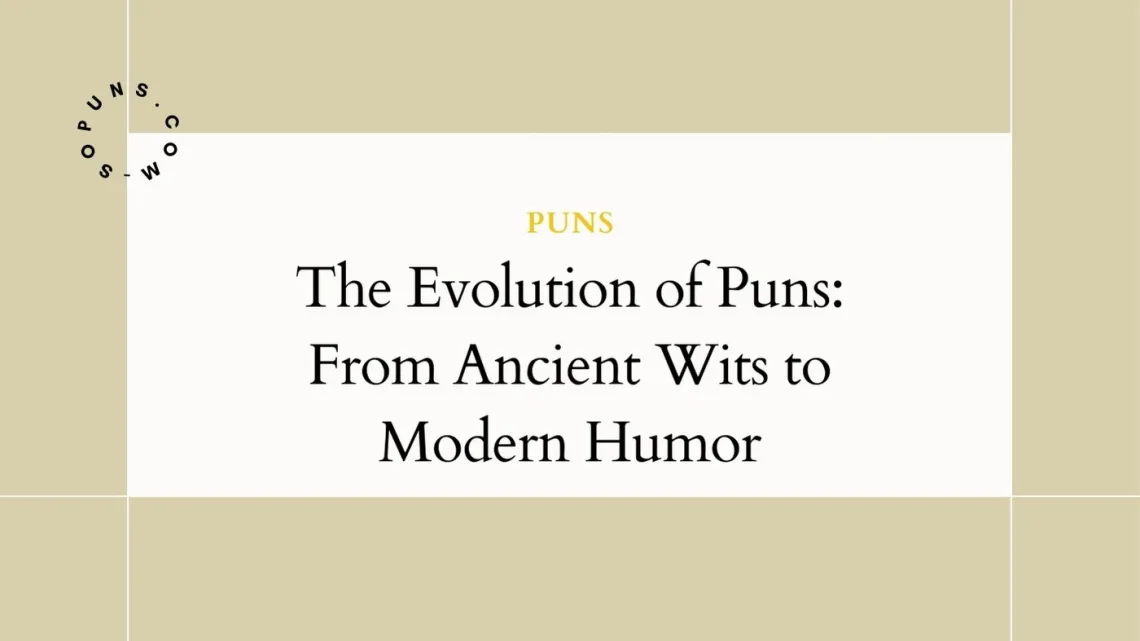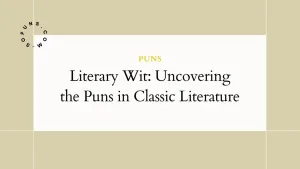Grab thy quill and scroll, fine folk, for we embark on a journey through the winding history of puns! From ancient oral tales to today’s digital boards, puns and wordplay have sparked mirth ‘cross the ages. Though some deem puns the lowest form of wit, these playful ploys persist in literary works, comedic routines, and everyday speech. Come with me on this pun-derful trek and learn how puns evolved from ancient wits to modern humor.
Punning Since Ancient Times
The pun hath ancient roots, my friends! Even in biblical texts and ancient Greek plays, clever wordplay provoked laughter. In the Bible’s Book of Samuel, Delilah “puns” on Samson’s name: “How can you say ‘I love you’ when your heart is not with me?” She repeats “heart” and “not with me” in a play on Samson’s name meaning “man of the sun” (Bible Gateway, 1 Samuel 14:15). This biblical pun dates back over 2,000 years!
Puns also arise in ancient Greek comedies. In Aristophanes’ The Frogs, the characters quip: “It wasn’t quite right at the end, you made my heart leap up to my mouth. It nearly choked me.” Here, Aristophanes jokes about the heart “leaping up” using a Greek pun between the words for “heart” and “throat.” Decidedly ribbiting!
Even in millennia past, playful word tricks tickled funny bones. While puns may seem silly, they have persisted through centuries of literature and drama.
Medieval Merriment and Renaissance Wordplay
The Middle Ages worshipped witty words, often in merry poetry or theatrical farces. Court jesters honed the punning craft, blending humor and wordplay to entertain nobility. Geoffrey Chaucer, renowned Medieval author, sprinkled The Canterbury Tales with puns to amuse readers. His Miller spoke of a parade where “many a flute and lilting horn/and pipes made of greene corne” play. Here, Chaucer jokes about “pypes made of Greene corne” meaning bagpipes fashioned from oat stalks.
The Bard himself, William Shakespeare, proved well-versed in punnery. Shakespeare’s plays brim with puns on character’s names like the Duke of York saying “chop off his head!” about the Earl of Suffolk, a pun meaning to “cut off” or “diminish.” Even Shakespeare’s poem titles punned like “Sonnet 18 Shall I Compare Thee to a Summer’s Day.” Here, “sonnet” itself sounds like “sun” to pun with summer sun. The Bard was but one Renaissance wordsmith who peppered prose with playful puns.
Pun-ditry Pioneers of the 18th and 19th Centuries
As puns trickled through early eras, their popularity surged in the 18th to 19th centuries as wordsmiths pioneered pun-packed humor writing. In 1719, British author John Arbuthnot published “John Bull’s Law Case” where “common lawyers” discover precedents in “common land” and “common places” – an entire satire built on one common pun!
Across the pond, America founded a pun-slinging patriot in Benjamin Franklin whose witty sayings like “love your neighbor, yet don’t pull down your hedge” punned on “hedge” and “hedge your bets”. Not to be outdone, America’s first grammar book by Lindley Murray in 1795 bore the punny title English Grammar, Adapted to the Different Classes of Learners. With a Penchant for English wordplay, early American statesmen and scholars cemented puns in their snappy sayings.
Even Mark Twain, renowned American author, quipped “Clothes make the man; naked people have little or no influence on society” – a cheeky play on words. From Franklin to Twain, American pioneers proved prolific punsters blending wit and wordplay into the nation’s cultural humor.
The Pun-omenon Spreads in the Victorian Era
As puns flourished in spoken and written works, they became hallmarks of Victorian literature and humor. Lewis Carroll’s Alice’s Adventures in Wonderland overflows with puns like the Mad Hatter’s tea party puzzling Alice with questions like “Why is a raven like a writing desk?” This penchant for puns characterized Carroll’s eccentric humor. Even Charles Dickens employed puns in character names, like Mr. Vholes, a “vampire” lawyer in Bleak House.
The explosion of puns extended into nonsense poetry and comic songs performed in British music halls. Writer Edward Lear composed limericks oozing with puns like:
There was an Old Man of Blackheath Who sat on his set of false teeth; He sang songs comic and witty, To amuse his wife Kitty, That amusing Old Man of Blackheath.
Lear’s rhymes played on “teeth/heath” and “Kitty/witty” dazzling Victorian audiences with clever word tricks. Music Hall numbers also employed puns, like in songs about “Ella Wheeler” who “wheels around the stage.” With puns permeating all media, the Victorian era solidified wordplay in British culture.
Pun Fun from Modern Literature to the Digital Era
The 20th century ushered in modern masters of literary puns like James Joyce who packed novels with complex puns. In Ulysses, Joyce plays with the name “Bloom” by having characters ask: “Are you blooming?” He also peppered Ulysses with multi-lingual puns blending English and Irish Gaelic. Not to be out-punned, fantasy author J.K. Rowling wittily named magical objects like “Pensieve” to pun “pensive” and “sieve” meaning to contemplate memories.

But literature is not the only modern haven for puns! The rise of digital communication opened new channels for pun-derful play. Internet chatrooms like Reddit and comedy websites thrive on punny jokes and wordplay. Memes too employ visual puns, like Grumpy Cat’s caption “I had fun once. It was awful.” Puns also abound on Twitter like comedy writer Tim Siedell quipping: “Don’t spell part backwards. It’s a trap.”
Whether scrolling social media or perusing bestsellers, puns continue to permeate modern life. Their wittiness and wordplay endure as hallmarks of humor and culture.
Why We Laugh at Puns: The Enduring Appeal of Playful Wordplay
What gives puny puns their perennial power to prompt laughs across lands and lifetimes? Some posit puns’ ubiquity stems from their simplicity – jokes grounded just in words require minimal background knowledge. Others believe the brain enjoys resolving the ambiguity of puns’ double meanings. But playfulness may best explain puns’ enduring appeal. Playing with words, bending meanings, and surprising listeners simply strikes humans as humorous regardless of era or language.
Puns invites participation in witty wordplay that tickles funny bones. Rather than lofty satire or complex irony, puns elicit mirth through lighthearted to silly manipulations of language. Their playful, lowbrow nature makes puns accessible ways to spark smiles across history. Though tastes change, human love for laughter and language endures making puns an evergreen way to rouse amusement.
So fret not if ye groan at goofy grandpa jokes or puerile puns! For silliness signifies puns’ success as playthings of language persisting for millennia. May puns continue to evolve and spread mirth, for their levity and wordplay appeal across ages. Laugh long and pun hearty, friends!
FAQ about the Evolution of Puns
When did puns first appear in history?
Puns and wordplay humor have very ancient origins, appearing in some of the earliest recorded literature. Puns are found in biblical texts over 2,000 years old and ancient Greek comedies starting around 600 BC.
How did puns evolve in the Middle Ages and Renaissance?
In the medieval era, puns were popular in the wordplay of court jesters and in literary works like Chaucer’s Canterbury Tales. During the Renaissance, puns flourished in the plays of Shakespeare and other dramatists.
When did puns gain widespread popularity?
Puns spread widely in the 18th and 19th centuries as authors like Benjamin Franklin and Mark Twain used them in snappy sayings and satirical works. In the Victorian era, puns boomed appearing across literature, nonsense poetry, songs, and humor writing.
How do puns continue to evolve in the modern era?
Today puns thrive online through social media jokes, memes, and comedy websites. They also persist in literature from Joyce to Rowling. As language and humor evolve, puns continue to adapt to new mediums.
Why have puns endured as a form of humor for millennia?
Linguists posit puns’ longevity relates to their simplicity, engaging the brain’s puzzle-solving functions. But above all, human love for playful language and lighthearted humor ensures puns’ persistence over time.
In Conclusion: A Punny Phenomenon
And so we conclude this winding tale of puns’ protean journey through human history! We’ve traced puns from ancient texts to medieval farces to today’s digital boards. We’ve spied wordplay sparking laughter from Roman amphitheaters to Victorian music halls. Though puns puzzle and provoke groans, their playful spirit persists. For at heart, we remain Homo Ludens, man the playful punster. May puns continue prompting smirks, groans, and technical explanations for generations to come!






No Comments